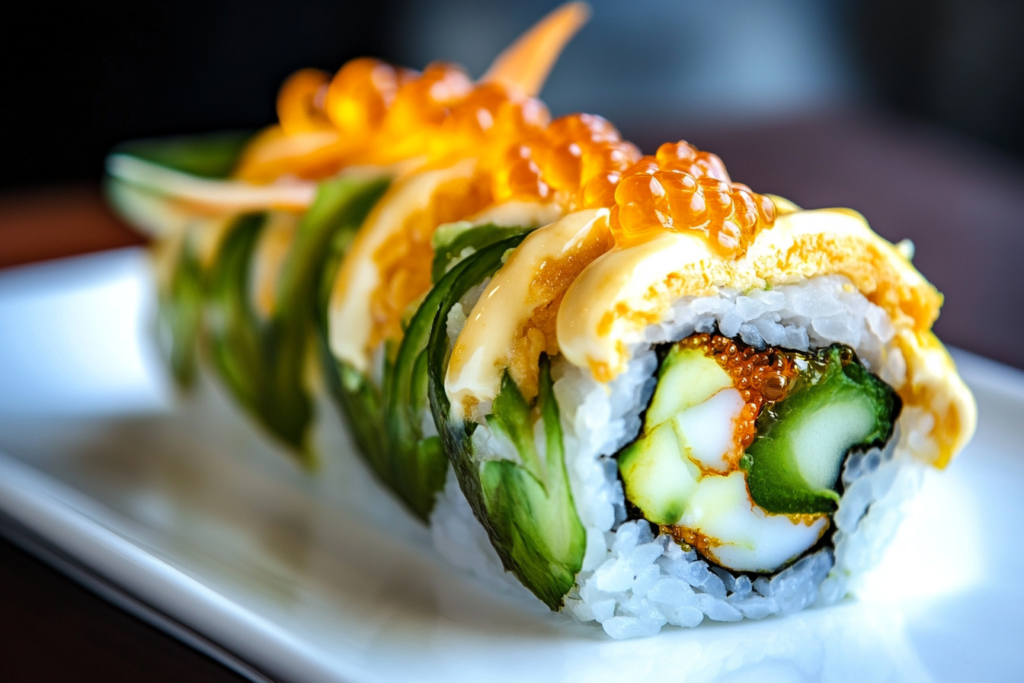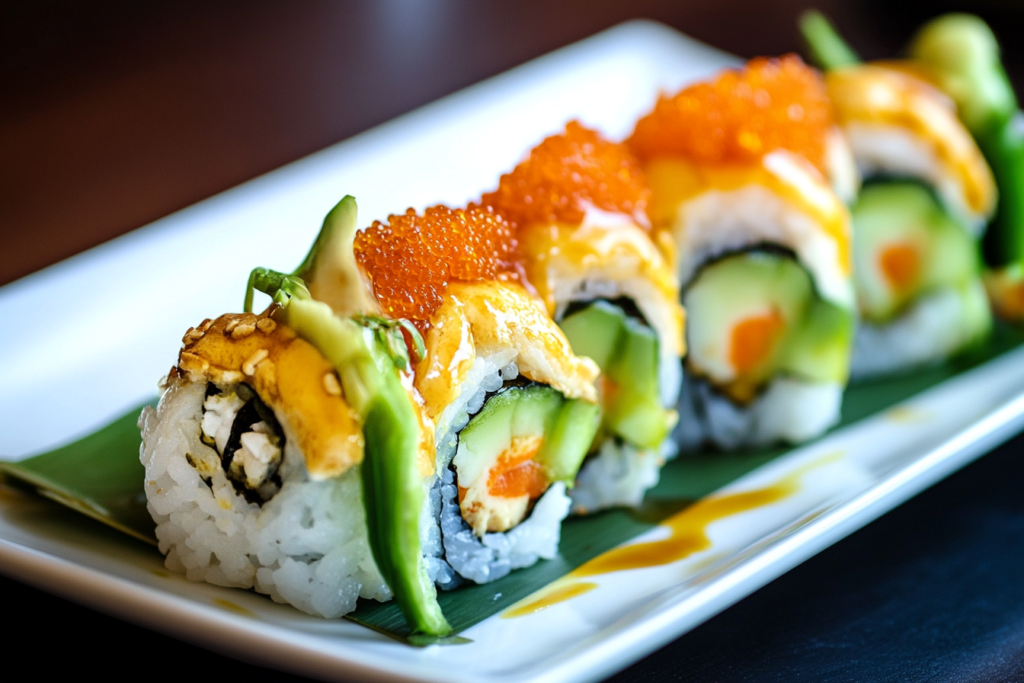Discovering the Allure of Dragon Roll Sushi
Have you ever sat down at a sushi bar and been captivated by a vibrant, dragon-like roll placed in front of you? That roll didn’t just promise flavor—it told a story. The dragon roll is more than just food; it’s an expression of culinary creativity, blending color, texture, and rich, layered taste into a single, unforgettable bite.
Whether you’re already a sushi enthusiast or someone who’s curious to try making it at home, understanding the dragon roll will deepen your appreciation for sushi’s artistic side. This guide walks you through everything you need to know—from what makes the roll special to how you can recreate it in your kitchen.
Table of Contents
What Is Dragon Roll Sushi?
At its core, a dragon roll is a type of uramaki, or inside-out sushi roll. Unlike traditional rolls that keep the seaweed on the outside, dragon rolls wrap the rice on the outside, hiding the nori (seaweed) and creating a softer, more polished exterior. But what sets it apart even more is the way it’s assembled and presented.
Here’s what typically makes up a classic dragon roll:
- Shrimp tempura for crunch and richness
- Avocado for creaminess
- Cucumber for a fresh contrast
- Eel or imitation crab for depth
- Sweet eel sauce drizzled on top for flavor balance
- Thin avocado slices layered like dragon scales
The result is a roll that looks like a coiled dragon—hence the name. It’s one of the most dramatic and flavorful rolls on the menu, and it’s gained popularity far beyond its Japanese roots.
Ingredients You Need for a Dragon Roll
When you decide to make this roll at home, having the right ingredients will make all the difference. What’s great about the dragon roll is how customizable it can be. You can stick with the classic elements or switch things out to suit your tastes.
Basic Ingredients Overview
| Ingredient | Quantity | Notes |
|---|---|---|
| Sushi rice | 2 cups (cooked) | Seasoned with vinegar |
| Nori sheets | 2 sheets | Seaweed for structure |
| Avocado | 1 | Thinly sliced for topping |
| Shrimp tempura | 4 pieces | Homemade or pre-made |
| Cucumber | ½ cup, julienned | Adds crisp freshness |
| Eel or imitation crab | ½ cup | Optional, but adds umami |
| Eel sauce | 2 tablespoons | Brings a sweet, smoky flavor |
| Sesame seeds | 1 teaspoon | For garnish and texture |
Making Dragon Roll Sushi at Home
There’s a special kind of joy that comes from crafting sushi in your own kitchen. It might seem complicated at first glance, but the process is surprisingly manageable once you understand the steps. You’ll need a bamboo rolling mat wrapped in plastic, a sharp knife, and a little patience.

Step-by-Step Instructions
- Prepare the Rice
Start with freshly cooked short-grain rice. While it’s still warm, season it with a mix of rice vinegar, sugar, and salt. Let it cool to room temperature. This gives your roll the proper balance of tang and stickiness. - Set Up Your Station
Place a sheet of nori on your bamboo mat, rough side up. Wet your hands slightly to keep the rice from sticking. Spread a thin, even layer of rice across the entire nori surface, pressing gently. - Flip and Fill
Carefully flip the nori over so the rice is now facing down. On the exposed nori side, arrange your fillings—start with shrimp tempura, then add cucumber and eel or crab. - Roll It Up
Begin rolling using firm, even pressure. Use the mat to help shape and tighten as you go. Once you’ve rolled it completely, give it one more gentle press to seal everything together. - Add the Avocado Topping
Slice your avocado thinly and fan the pieces out across the top of the roll. You can use a piece of plastic wrap to press and mold them into place, giving that signature dragon scale effect. - Garnish and Slice
With your knife slightly damp, slice the roll into eight equal pieces. Drizzle with eel sauce and sprinkle on sesame seeds before serving.
Flavor Variations and Custom Toppings for Dragon Roll Sushi
You don’t need to stick to just one version of the dragon roll. Part of the fun of making sushi at home is the creativity it invites. Whether you want something a bit lighter, spicier, or vegetarian-friendly, small tweaks can make a big difference.
Popular Variations to Try
- Spicy Dragon Roll – Add a layer of spicy mayo inside or drizzle it over the top. Mix sriracha with Japanese mayo for a bold kick.
- Vegetarian Dragon Roll – Replace shrimp tempura with tempura-fried sweet potato or tofu and keep the avocado topping.
- Rainbow Dragon Roll – Add a variety of colorful sashimi (like tuna, salmon, and yellowtail) on top of the avocado for a visually stunning presentation.
- Crunchy Dragon Roll – Sprinkle crispy tempura flakes or fried onions over the top for extra texture.
- Unagi Dragon Roll – Use grilled eel both inside and on top for a rich, smoky flavor.
Your dragon roll can be as simple or elaborate as you want. The key is maintaining balance—each bite should have creaminess, crunch, freshness, and that signature umami undertone.
Comparing Homemade vs. Restaurant-Style Dragon Rolls
When you order a dragon roll at a sushi restaurant, you’re paying for presentation, technique, and convenience. But when you make it at home, you’re in control of every ingredient—and it can be surprisingly rewarding.
Restaurant Rolls
- Often use high-end ingredients like real unagi (eel)
- Typically have more elaborate plating and garnishes
- May use sauces with hidden sugar or additives
Homemade Rolls
- Fresher ingredients tailored to your dietary needs
- Cost-effective over time
- Easy to customize based on taste and preference
So which is better? That depends on your goals. If you’re seeking inspiration for more sushi types to try at home, you’ll enjoy exploring detailed guides like this one on Rainbow Roll Sushi, which offers a colorful twist to the standard sushi roll. You might also like the Crunchy Roll Sushi, perfect if you’re after bold texture, or the savory delight of Spider Roll Sushi, made with soft shell crab for a unique taste. For a traditional Japanese preparation, check out the step-by-step instructions from Just One Cookbook. And if you’re on the lookout for a simplified, health-conscious version, The Big Man’s World offers a practical approach worth bookmarking.
Nutritional Information: What’s in a Dragon Roll?
A single dragon roll contains a balanced mix of carbohydrates, healthy fats, and protein. Still, the calorie count can vary depending on the ingredients and portions.
| Nutrient | Approximate Value (Per Roll) |
|---|---|
| Calories | 400–500 kcal |
| Carbohydrates | 50–60g |
| Protein | 15–20g |
| Fat | 15–25g |
| Sodium | 600–900mg |
If you’re tracking your intake, consider making smaller rolls, reducing the amount of eel sauce, or using brown rice for added fiber. Even cutting down on the amount of avocado can shave off a few calories while keeping the creaminess intact.
Tips for Mastering the Roll Technique

You’ve probably noticed that rolling the sushi is the trickiest part. It’s not about rushing—it’s about staying consistent and confident with your hands. Here are a few ways to improve your rolling skills:
Best Practices for Sushi Success
- Use Plastic Wrap Over the Mat
This prevents the rice from sticking and helps shape the roll tightly. - Wet Your Knife Before Slicing
A sharp, damp knife glides through the roll more smoothly without crushing the ingredients. - Don’t Overstuff the Roll
It might be tempting to pile on the fillings, but too much makes it harder to roll and seal. - Chill Before Cutting
Letting the roll sit for 5–10 minutes helps everything firm up, making slicing cleaner.
Sauce Pairings and Garnishes That Elevate Flavor
A dragon roll is delicious on its own, but the right sauce or topping can make it even better. Don’t be afraid to explore combinations that highlight or contrast the roll’s core flavors.
Popular Add-ons
- Eel Sauce (Unagi Sauce) – Sweet and savory; enhances the grilled flavor
- Spicy Mayo – Brings heat and creaminess
- Ponzu Sauce – Adds a light citrus kick
- Togarashi – A Japanese spice blend for mild heat
- Pickled Ginger and Wasabi – Traditional palate cleansers
Each of these elements can be added directly to the roll or served on the side, giving you flexibility based on who you’re serving or what you’re in the mood for.
Frequently Asked Questions About Dragon Roll Sushi
1. Is Dragon Roll Sushi Raw or Cooked?
That depends on how it’s prepared. While many sushi rolls contain raw fish, the dragon roll is typically made with cooked ingredients like shrimp tempura and grilled eel (unagi), making it a great choice if you’re not ready for raw fish.
2. Can I Make a Dragon Roll Without Eel?
Absolutely. You can substitute eel with imitation crab, smoked salmon, tofu, or even roasted vegetables. The flavor will change slightly, but you’ll still get that delicious fusion of texture and taste.
3. What Does Dragon Roll Taste Like?
It’s a flavor bomb. You’ll taste the crispy shrimp tempura first, followed by the buttery richness of avocado, the tang from the sushi rice, and the sweet-savory glaze of eel sauce. There’s also a satisfying crunch from cucumber and sesame seeds.
4. Do I Need a Bamboo Mat to Make It?
Yes, a bamboo sushi rolling mat (called a makisu) helps you shape the roll tightly. Wrap it in plastic wrap to keep it clean and make rolling easier. If you don’t have one, a clean kitchen towel can work in a pinch, though it’s not quite as precise.
5. How Long Does It Take to Make a Dragon Roll?
On average, about 45 minutes from start to finish. That includes cooking and seasoning the rice, preparing your ingredients, and assembling the roll. Once you get the hang of it, you’ll shave off time with practice.
Wrapping Up: Why You Should Try Making a Dragon Roll at Home
Making dragon roll sushi at home isn’t just about saving money—it’s about building a connection with your food. You get to choose your ingredients, control the freshness, and tailor every element to your taste. Plus, it’s a fantastic way to impress friends or enjoy a quiet, gourmet night in.
By following the steps and tips outlined in this guide, you’re already ahead of the curve. You understand the components, know the techniques, and even have ideas for creative twists. Whether you stick with the classic version or explore bold variations, the dragon roll gives you endless room to play.
If you’re ready to dive even deeper into sushi mastery, don’t miss our other popular guides:
- Rainbow Roll Sushi – A Colorful Sushi Delight
- Crunchy Roll Sushi – For Texture Lovers
- Spider Roll Sushi – Bold and Unique
You’ll be rolling like a pro in no time.

